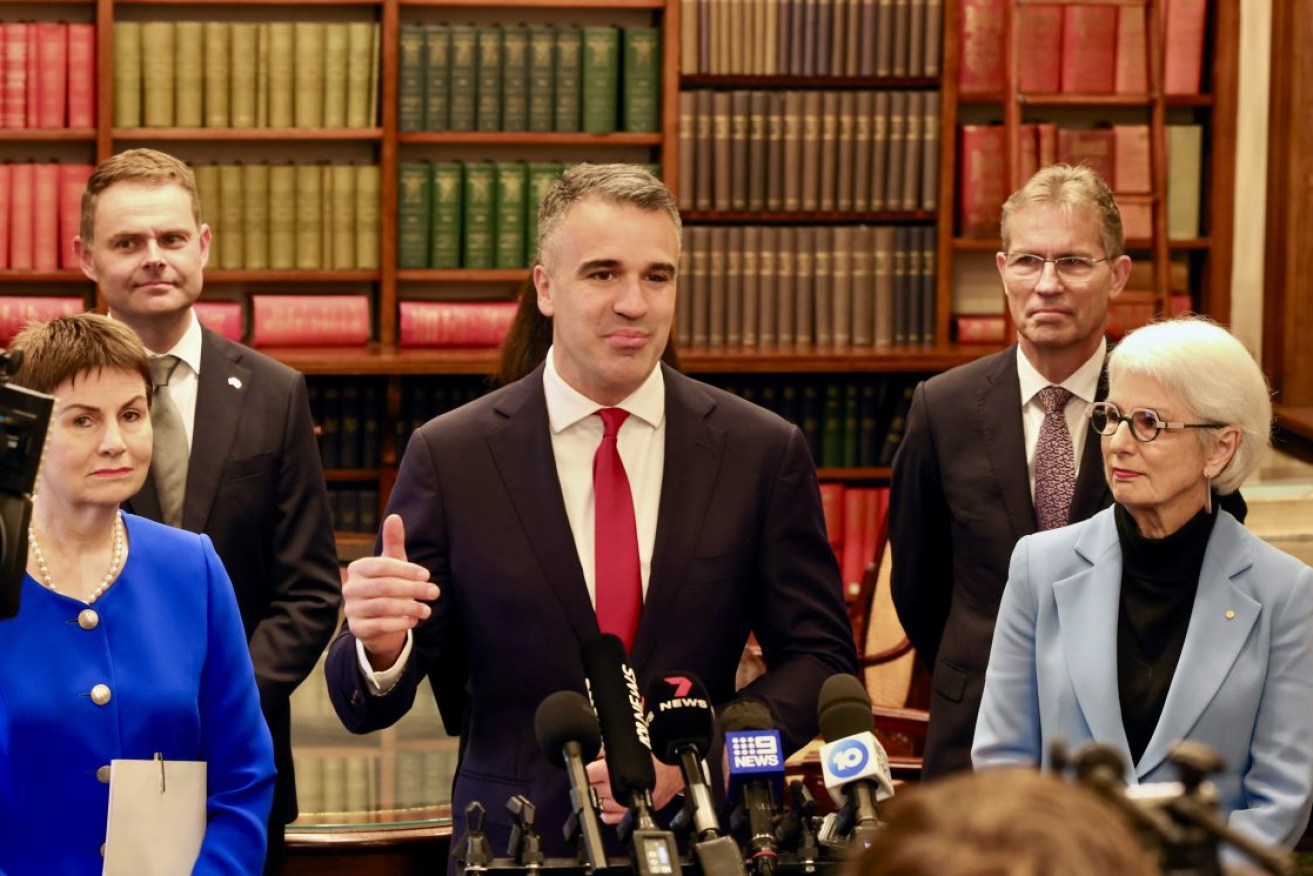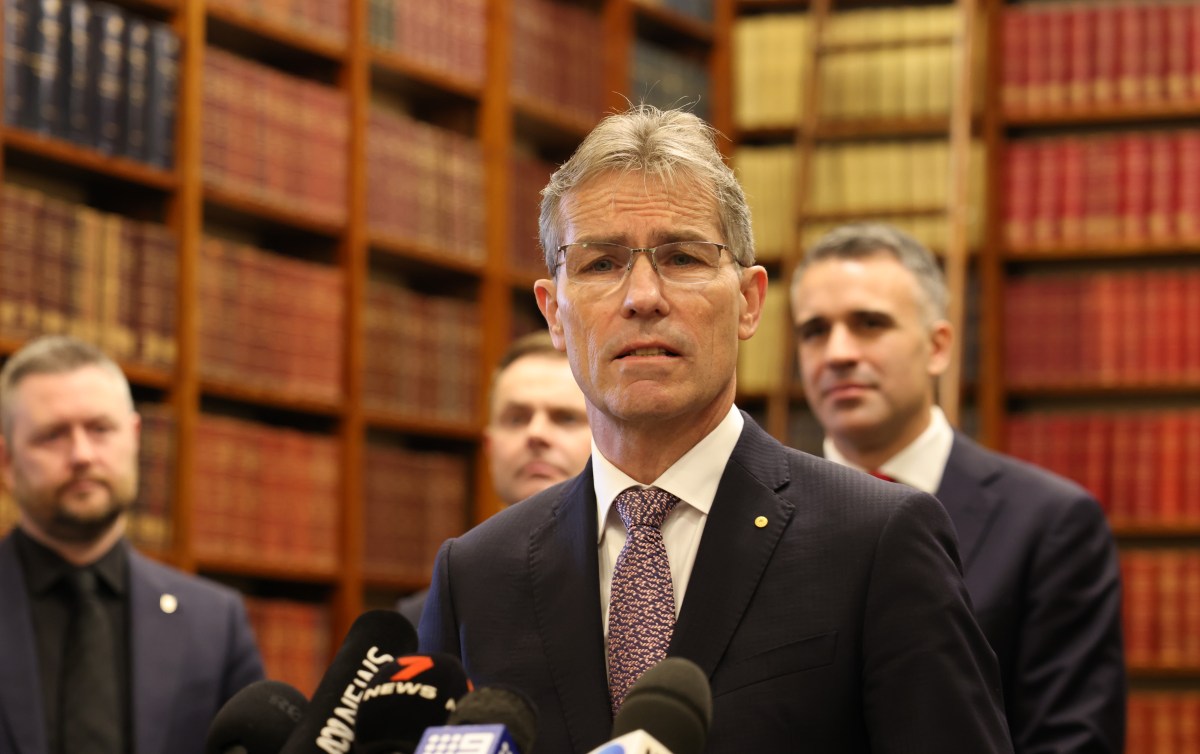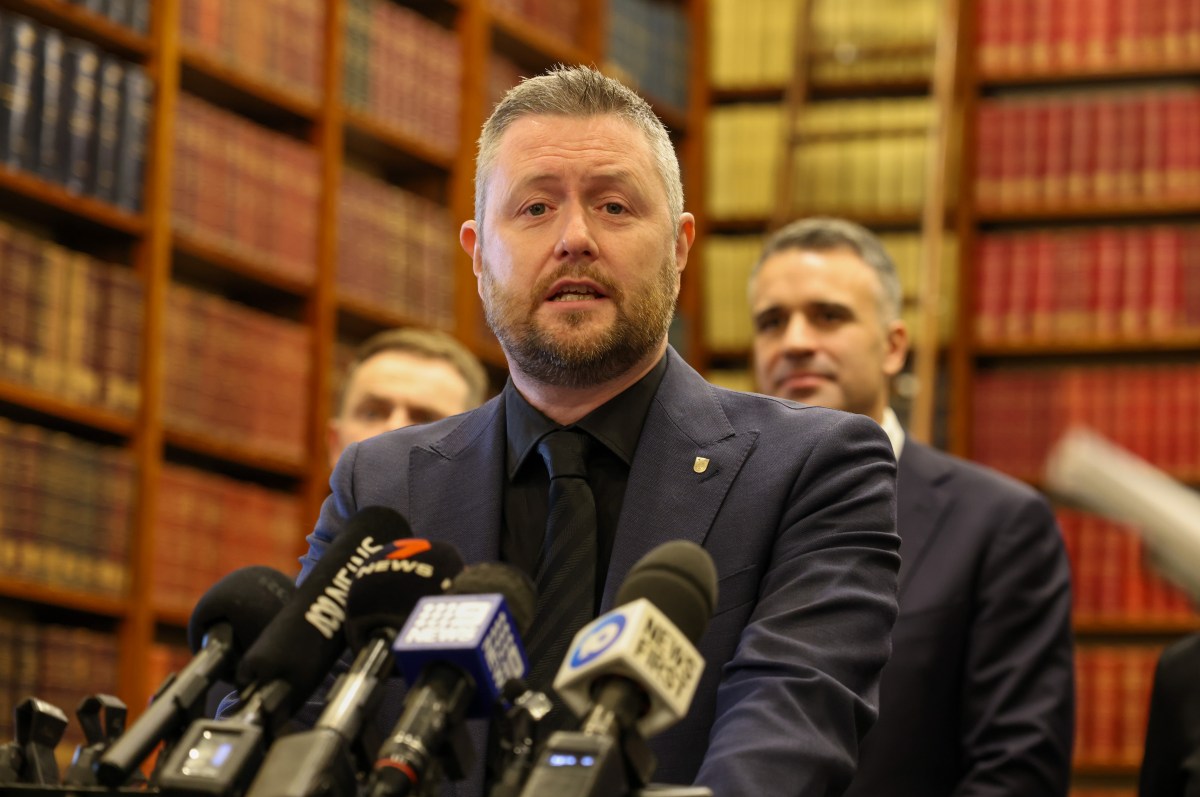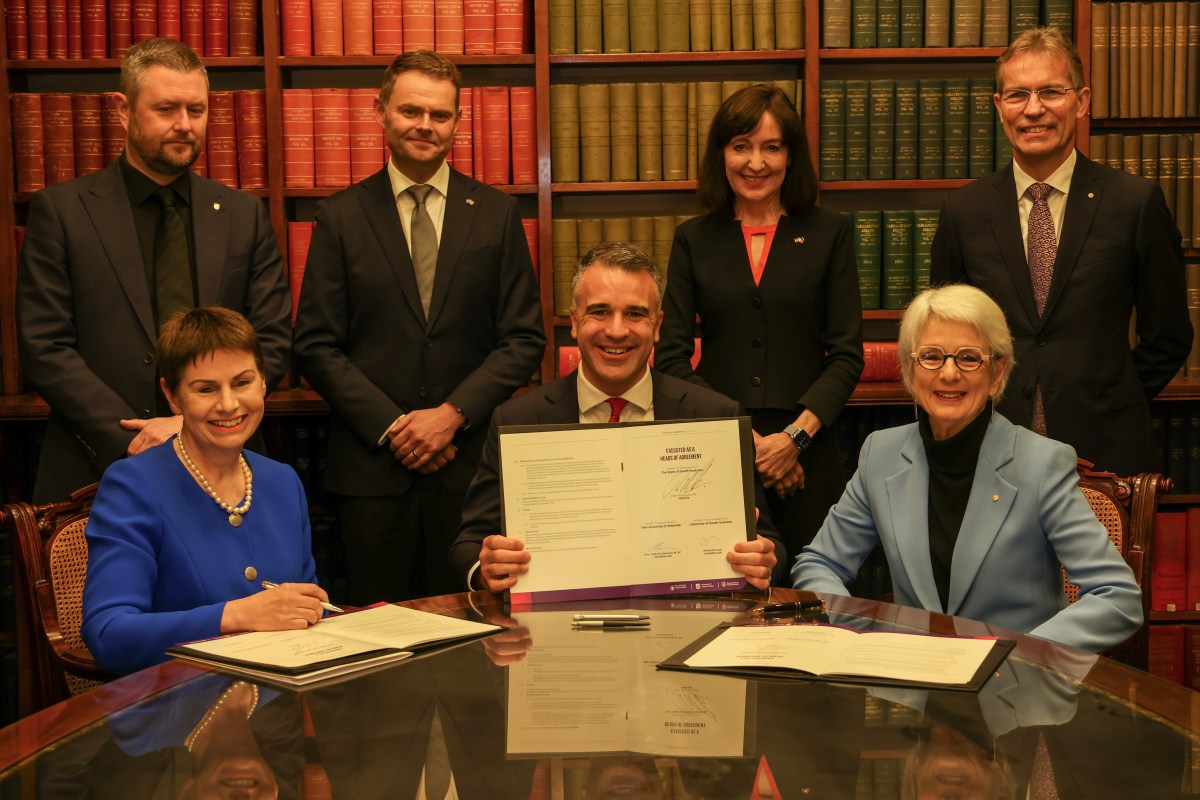‘Delay is denial’: Premier, universities warn Upper House over inquiry into merger deal
The Liberal Opposition is poised to back an Upper House inquiry into the deal to merge the universities of Adelaide and South Australia, as details of the business case remain under wraps amid warning that delays in passing merger legislation could cost the state hundreds of millions.


(L-R) UniSA chancellor Pauline Carr, Treasurer Stephen Mullighan, Premier Peter Malinauskas, University of Adelaide vice-chancellor Peter Høj and University of Adelaide chancellor Catherine Branson at today's university merger press conference. Photo: Tony Lewis/InDaily
Premier Peter Malinauskas, University of Adelaide chancellor Catherine Branson and University of South Australia chancellor Pauline Carr this morning signed a formal heads of agreement that enshrines a $445.5m state government funding contribution to a newly merged “Adelaide University” scheduled to open on January 1, 2026.
The chancellors emailed staff at around 8pm Saturday night to say that the respective university councils had agreed to pursue a merger, which will likely create Australia’s largest educator of domestic students.
The deal means the government will not proceed with the commission to pursue a merger it was going to set up if the universities did not “voluntarily” agree to the union.
The state government and universities say the new Adelaide University will add $500m to the state’s economy per year, educate more than 70,000 students and create an additional 1200 jobs.
But the full business case and feasibility assessments for the amalgamation pushed by Labor, which the two universities have been working on for more than six months, will not be released to the public.
So far, UniSA and the University of Adelaide have only released a 19-page “extract” of its full transition plan. A four-page policy document and the heads of agreement were also distributed to journalists at a press conference today.
The vice-chancellors of the University of Adelaide and UniSA were asked if they would commit to releasing the business case and feasibility studies “in full”.
University of Adelaide vice-chancellor Peter Høj replied: “We will see how we can summarise aspects of that business case for public consumption.
“But you will understand that universities are operating in a very competitive national and global market.
“And it would not necessarily be in the state’s interest and the new institution’s interest for everybody to have access to how we believe we can position ourselves stronger in that market for the benefit of South Australia.”
Malinauskas, asked whether the state government would release the business case, said: “That work has been done by the universities themselves.
“So, that is their work to make their own decisions about and I’m sure both vice-chancellors are happy to answer that question.”

University of Adelaide vice-chancellor Peter Høj has warned MPs over the merger: “If you’re worried about the state’s finances – don’t hold this up. Photo: Tony Lewis/InDaily
Malinauskas also used his opening remarks at today’s press conference to warn Upper House MPs not to delay passage of the legislation needed to establish the newly-merged Adelaide University.
The government does not have a majority of MPs in the Upper House and will need support from either the Opposition or crossbenchers SA-Best to establish a new university, with the Greens firmly opposed.
Greens MLC Robert Simms today said that he would move to refer any university merger legislation to a Select Committee in the Upper House, with his inquiry to have the support of SA-Best and the Opposition.
“There are serious questions here about the business case, the level of government investment, the governance of the new institution and the impact of any proposal on staff and students,” Simms said.
“The idea that the Upper House should simply wave through reforms of these key public institutions is absurd.”
Opposition education spokesperson John Gardner told InDaily: “It is absolutely appropriate that detailed scrutiny, such as a parliamentary committee might provide, be undertaken to look into this proposal.
“It’s extraordinarily surprising that the Premier would seek to see that as a political approach – it was the government’s own idea to have a commission to look into the detail here.”
According to the universities’ transition plan, the new legislation needs to be passed in the first quarter of 2024.

UniSA vice-chancellor David Lloyd said a delay in state legislation to establish a new university is the “highest risk” part of creating a new university. Photo: Tony Lewis/InDaily
Asked about the prospect of an Upper House inquiry, Malinauskas said there had already been “an extraordinary amount of scrutiny on this deal from the universities themselves.”
He said an inquiry that “speaks to delay to achieve a political outcome would be incredibly disappointing” and suggested it could impact the current functioning of the two universities.
“I, for one, am not about to prejudge the outcome of the parliament around inquiries or the passage of the bill or otherwise,” Malinauskas said.
“But… delay is denial here.
“Universities run to a particular drumbeat of enrolments from students… there is a drumbeat that has to be adhered to.
“There is an objective here to have this new university up and running by the year 2026, and if there is delay for the sake of delay then of course that will compromise the universities being able to function between now and when the new university is established.”
Malinauskas said the two universities would still have to run independently of each other up until January 2026 “and if uncertainty is the name of the game, then that of course will undermine their capacity to do that”.
He also insisted the government is “really keen to work constructively” with both the Opposition and crossbench to shape the new institution.
“This is not the government riding roughshod over the crossbench or the Opposition – a lot of work has got us to this point and a lot of work is to be done,” he said.

Premier Peter Malinauskas holding up the heads of agreement signed by him and the two university chancellors today. Photo: Tony Lewis/InDaily
Both Høj and UniSA vice-chancellor David Lloyd also urged the Upper House not to delay passage of legislation.
Lloyd claimed a delay of six months would cost the state $250m.
“I think the risk that an inquiry precipitates for us is one of timing,” Lloyd said.
“There are an infinite number of things that we have to do between now and January 1st, 2026, to have an institution that can open its doors.
“And delay in legislation is the highest risk piece in that activity.”
Lloyd said the new Adelaide University would have to be registered with accrediting bodies and requires changes to federal legislation so it can receive Commonwealth funding.
“They all flow from having state legislation passed,” Lloyd said.
“The legislation delay impact is one on students, it’s on staff, it’s uncertainty.
“If you think about this institution delivering $500 million extra to the economy when it’s actually on full swing. If we delay by a year we’ve lost that $500 million.
“If we delay it by six months we’ve lost $250m. And I think that’s the consequence of a commission.”
Høj also issued his own warning to the parliament, saying: “If you’re worried about the state’s finances – don’t hold this up.
“Because this is the net addition of a very high order annually, so there is a risk in delay.”
Both universities have committed to “no compulsory redundancies or retrenchment of staff” from now until 18 months after the new university opens.
In their December agreement, the two universities agreed to “no net job losses”.
Lloyd conceded the no net job losses term had to change because “the reaction from our staff was that was so ambiguous they didn’t know how to deal with it.
“We can’t give any more certainty than to say that for a four-year period we’re going to have no forced redundancies, no retrenchments,” he said.
“Individuals may actually have roles that they move around in but we’re going to support people right the way through.”
The two vice-chancellors and the Premier also downplayed the results of a survey conducted by the National Tertiary Education Union (NTEU) SA branch.
The NTEU survey showed only 25 per cent support for the merger among 1100 staff – union and non-union – across the state’s three public universities.
Høj argued the survey would look different now that the universities have committed to no redundancies until halfway through 2027.
“The prospect of merging two institutions and people having never seen university mergers – but they’ve seen corporate mergers – I think it’s natural that people get nervous,” Høj said.
“Those surveys were made before we actually made the commitment through the two councils to no redundancies.
“So I think this survey would look very different now.”
Malinauskas also downplayed staff concerns, arguing that the merger is about “hiring more academics, not less”.
“While I can understand that anxiety that exists amongst the staff body, in practice, it was never… substantiated by the work that has been undertaken to allow us to get to this point,” he said.
“This isn’t about reducing the size of staff – it’s about growing.
“By 2024, the universities’ own analysis and business case shows there’ll be 1200 additional staff required for the new institution than what is required today.”
Malinauskas has strongly backed the merger and vowed in March to “make” it happen regardless of the decision of the respective university councils.
If the two universities did not agree to amalgamate, the state government would have re-established a $1m public commission of inquiry to determine ways for them to amalgamate.
But UniSA vice-chancellor Lloyd denied his institution was being forced into a merger.
“It was asked before whether we could say ‘no’, I mean we have form – we’ve said no before,” he said.
“If this had not stood up in terms of its own merit, we wouldn’t be standing before you here now.”
The bulk of the state government funding support for the merger comes via two perpetual funds: a $200m “research fund” to support the new university’s research and $100m “student support fund” to allow greater enrolment of students from low socio-economic groups.
The two funds will be managed by Funds SA and enshrined in legislation.
Flinders University, which chose not to participate in the merger process, will not have access to the fund, but Malinauskas said the state government had an “appetite” to work with Flinders and left open the door to provide separate funds to them in future.
The 14-member Transition Council of the new Adelaide University will be tasked with leading a global recruitment process for the institution’s first vice-chancellor in 2027.
Lloyd, asked whether either he or Høj would he would be putting their names forward, said: “Ask us 2026, we’ve got a lot to do between now and then.”




